Gafforov Sunatullo Amrulloevich1, Muminova Dilnoza Rakhimovna2
1Center for the Development of Professional Qualification of Medical Workers under the Ministry of Health of the Republic of Uzbekistan, Tashkent, Uzbekistan
2Tashkent State Dental Institute, Tashkent, Uzbekistan
Correspondence to: Gafforov Sunatullo Amrulloevich, Center for the Development of Professional Qualification of Medical Workers under the Ministry of Health of the Republic of Uzbekistan, Tashkent, Uzbekistan.
| Email: |  |
Copyright © 2024 The Author(s). Published by Scientific & Academic Publishing.
This work is licensed under the Creative Commons Attribution International License (CC BY).
http://creativecommons.org/licenses/by/4.0/

Abstract
According to literary data, there is a demand for the assessment of the dental status of workers in industrial enterprises such as chemical and mining-metallurgical ones, which have a harmful effect on the workers' bodies, including the organs and tissues of the oral cavity. Additionally, when exposed to low-intensity harmful factors, training compensatory reactions create a state of nonspecific increased resistance. The results determine the need for in-depth scientific research in this direction. Objective and tasks: The aim of the study was to determine the dental status, level, and structure of dental morbidity among workers of certain industrial enterprises in Uzbekistan. Materials and methods: The total study population consisted of 1600 individuals, including 1450 workers (the main group) from three studied industrial enterprises: Fergana Oil Refinery (FNR – MG-1) – 420; Almalyk Mining and Metallurgical Combine (AMMC – MG-2) – 425; and Navoi Chemical Plant (NCP – MG-3) – 605 workers, as well as 150 individuals in the control group (CG), who sought dental care at the Tashkent State Dental Institute clinic. A general dental examination was conducted, including the determination of tooth sensitivity, pain and discriminatory sensitivity (PDS), taste perception threshold, and functional mobility of taste reception on the tongue (FMT), enamel resistance to caries, microhardness (MH) of enamel and dentin, assessment of periodontal tissue condition, determination of periodontal-papillary-alveolar (PPA) and hygienic conditions of the oral cavity, and pH of mixed saliva. The obtained data were processed using statistical methods. Results: It has been determined that the levels and proportions of major dental diseases among workers in the studied industries remain quite high, with averages as follows: prevalence of caries – 90.43%; caries increment – 0.89%; chemical necrosis of teeth – 18.43%; pathological tooth abrasion – 33.2%; mechanical enamel damage – 19.9%; deformation and defects of teeth and dental arches – 18.5%; periodontal tissue diseases – 74.7%; diseases of the oral mucosa and peri-oral tissues – 38.7%; need for prosthetics – 58.4%; pathologies and anomalies of dental arches and joints – 36.6%. Compared to individuals in the control group, all types of dental pathologies were identified at rates 1.5 to 5.5 times higher among the workers. Additionally, almost all functional indicators of nonspecific reactivity of periodontal tissues in workers are disturbed. Conclusion: It has been established that the prevalence of major dental diseases among workers is quite high, with a noted decrease in the excitability threshold of teeth, peri-dental tissues, and oral mucosa, along with disturbances in pain, taste, and discriminatory sensitivity of the oral cavity. Furthermore, there is a deterioration in the microhardness of tooth hard tissues. Based on these results, the authors plan to continue their research to determine the etiological factors of each pathological process.
Keywords:
Dentistry, Oral pathology, Harmful factors, Functional examination
Cite this paper: Gafforov Sunatullo Amrulloevich, Muminova Dilnoza Rakhimovna, Assessment of the State of Oral Cavity Organs and Tissues of Employees of Certain Industrial Enterprises of the Republic of Uzbekistan, American Journal of Medicine and Medical Sciences, Vol. 14 No. 4, 2024, pp. 885-893. doi: 10.5923/j.ajmms.20241404.18.
1. Introduction
It is known that industrial enterprises continue to expose workers to high concentrations of toxic substances. The problem of prolonged exposure to low-intensity toxic factors, including on the organs and tissues of the oral cavity, is gaining increasing importance. Moreover, when exposed to low-intensity chemical factors, compensatory reactions develop, leading to a state of nonspecific increased resistance. Any reaction of the organism to the action of a chemical substance cannot be indifferent to it. Pathological phenomena occurring in the oral cavity often lead to severe changes throughout the body. The protective function of the organs and tissues of the oral cavity is formed as a reaction aimed at maintaining the normal functioning of the respiratory and digestive systems, while also maintaining its significance for other systems. Changes occurring in the organs and tissues of the oral cavity may serve as a source of pathological impulses, leading to the development of various systemic disorders. Furthermore, the issue of the occurrence of dental diseases among workers in industrial enterprises has not been fully studied, making this problem not only of scientific interest but also of significant economic and social importance in Uzbekistan.Objective and tasks: The aim of the study was to determine the dental status, level, and structure of dental morbidity among workers of certain industrial enterprises in Uzbekistan.
2. Materials and Methods
The total study population consisted of 1600 individuals, including 1450 workers from three studied industrial enterprises: Fergana Oil Refinery (FNR – MG-1) – 420; Almalyk Mining and Metallurgical Combine (AMMC – MG-2) – 425; and Navoi Chemical Plant (NCP – MG-3) – 605 workers, as well as 150 individuals in the control group, who sought dental care at the Tashkent State Dental Institute clinic. Of the total number of individuals surveyed, men accounted for 67.7% and women for 35.3%. It was also noted that the most numerous age group was those aged 30 and above, constituting 72.2% of the total, with 47.0% being men and 25.2% women.Table 1. Distribution of examined individuals by age and gender
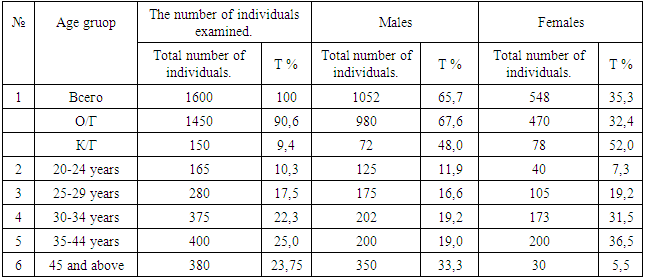 |
| |
|
Dental examinations of workers from the main workshops of FNR, AMMC, and NCP were conducted with the participation of medical sanitary personnel from the enterprises, who filled out cards according to a unified metrological principle. When collecting medical history, attention was paid to subjective sensations in the oral cavity. During interviews, dental complaints were clarified, and the periodontal tissues, oral mucosa, and lips were examined, with attention to the presence of fillings, dental prostheses, and their condition. Tooth sensitivity was determined using methods developed by L.R. Rubina (1958) and S.A. Gafforov et al. (2002). Pain and discriminatory sensitivity (PDS) of the oral mucosa were assessed using methods developed by M.V. Sisneva, B.A. Khvatova (1974), M.V. Bekmetova (1983). The taste perception threshold and functional mobility of taste receptors on the tongue were determined using methods developed by N.S. Zayko (1958). Enamel resistance to caries was assessed according to methods developed by V.R. Okushko, L.I. Kosareva (1983). Microhardness (MH) of enamel and dentin were evaluated using methods developed by S.M. Remizova (1965). The condition of periodontal tissues was assessed using Schiller-Pisarev tests. Periodontal-papillary-alveolar (PPA) and hygienic conditions of the oral cavity were determined according to L.V. Fedorova (1982). The capillary resistance of periodontal tissues was assessed using methods developed by Kulazhenko (1960), and the pH of mixed saliva was determined using calorimetric methods. The obtained data were processed using statistical methods, specifically the traditional Student's t-test, with the use of application software for IBM PC AT.
3. Results and Discussion
Our research results revealed that among the workers in the main groups, the prevalence rates of dental caries were very high (see Table 2), reaching 92.8% at FNR, 89.9% at AMMC, and 88.6% at NCP. Similar results were obtained when studying the intensity of dental caries (caries, fillings, extractions - CFE) – 11.8, 10.2, and 10.4 respectively. When examining the prevalence rates of caries according to age, it was found that both among workers in the main groups and in the control group, these rates increased proportionally with age - the older the age group, the higher the rates. This also applied to the intensity of dental caries. Characterizing the levels of CFE rates overall among workers from all plants, they were higher in women than in men: at FNR - 41.8% vs. 36.2%; at AMMC - 39.8% vs. 34.6%; at NCP - 39.2% vs. 35.2% respectively. In the main groups, the rates of dental caries increment were highest in the age group of 25-29 years (1.5, 1.4, and 1.1 respectively by production), and in older age groups (45 and above), the rates decreased (from 0.60, 0.68, and 0.58 respectively). In the control group, this indicator differed significantly - it was lower, ranging from -0.32, -0.28, to -0.44 respectively.Table 2. The increase in caries prevalence among the examined individuals depending on age and gender
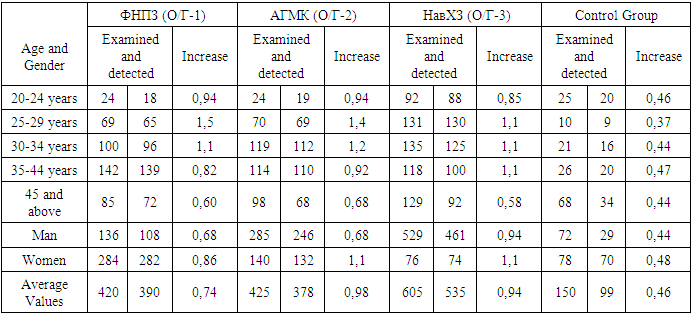 |
| |
|
It was found that the frequency of tooth damage due to chemical necrosis (CN) among workers was as follows: at FNR - 15.23%, at AMMC - 17.64%, at NCP - 22.64%; in the control group - 7.69%. Cases of CN tooth damage were observed with approximately the same frequency in both genders. Early signs of CN for workers included a feeling of bitterness, tooth pain, increased sensitivity to cold stimuli, loss of natural shine, appearance of longitudinal-transverse cracks, erosions, and roughness on the enamel. Necrotic lesions in the area of masticatory teeth were less common, and they were always accompanied by necrosis of frontal teeth.In individuals of different age groups, depending on the type of production, the frequency of CN varied. Among NCP workers, the frequency of CN tooth damage ranged from 10.9% to 31.1%, decreasing after 34 years of age. This trend was also observed for AMMC workers (from 12.5% to 21.8% respectively) and FNR workers (from 8.3% to 21.0% respectively). With age, the frequency of CN usually increased, but in the age group of 45 years and older, a decrease in its frequency was observed.Table 3. Frequency of tooth lesions with chemical necrosis, mechanical damage, pathological abrasions, and dental calculus in the examined individuals depending on age (M+ in %)
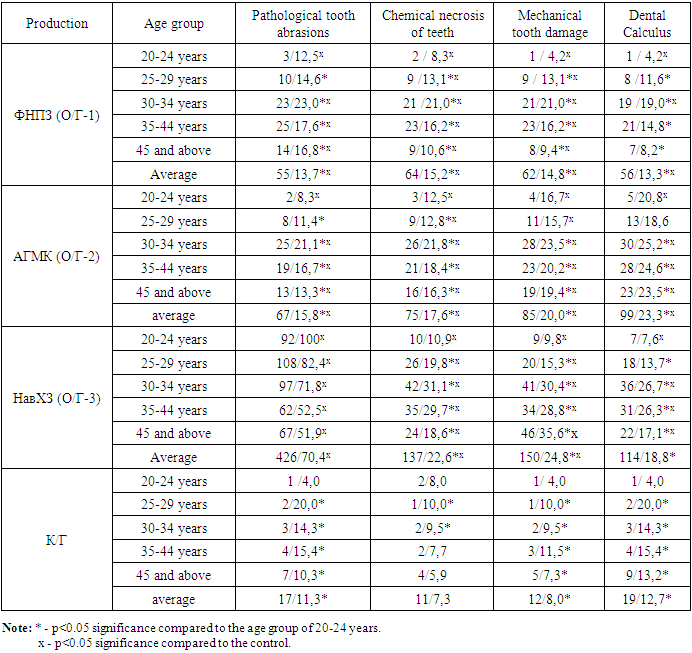 |
| |
|
The pathological abrasion (PA) of teeth among workers surveyed at FNR was found to be 13.7%, at AMMC - 15.8%, at NCP - 70.4%, and in the control group - 11.3%. Interestingly, among workers at NCP, PA of teeth was encountered 3 to 5 times more frequently than in other research groups. An interesting pattern was also noted: at the age of 20-24 years, this condition was observed in 100% of cases, while in the age group of 45 years and older, the frequency decreased by almost 2 times (to 51.9%). Regarding gender differences, it was found that among NCP workers, men experienced PA of teeth more frequently than women (66.1% and 33.9%, respectively). Patients complained of chewing function impairment, elements of bite disruption - with developing PA of teeth, concomitant CN resulted in lower face height reduction, pronounced nasolabial folds, altered facial appearance, indicating all elements of decreased bite height.The frequency of mechanical damage to hard tooth tissues (MDHTT) was highest among NCP workers (24.8%), lowest at FNR (14.8%), and 8% in the control group. Regarding gender, no significant differences were found between NCP, AMMC, and FNR, but in the control group, it was noted that women experienced MDHTT 1.8 times less frequently. It was also established that among the majority of surveyed young individuals (aged 20 to 30 years), the frequency of MDHTT was 1.5-3 times lower compared to those aged 35 and older.According to literature data, the prevalence of dental calculus and deposits (DC and DD) among professional population groups is quite high. In our studies, DC and DD were found in FNR workers - 13.3%; AMMC - 23.3%; NCP - 18.8%; while in the surveyed control group - 12.6%. Moreover, DC and DD were mainly detected in the area of lower frontal and upper lateral teeth. Additionally, DC and DD were more frequently observed in men, both among workers and in the control group.The results revealed a relatively high frequency of periodontal tissue diseases (PTD) (Table №4), with inflammatory processes predominating. Gingivitis was found on average in FNR workers - 17.8%; AMMC - 15.5%; NCP - 21.5%, with all workers in the main groups showing high frequency in the 20–34 age groups. In our observations, gingivitis in workers was characterized by swollen, edematous gums that, due to inflammatory exudate, became loose, no longer tightly attached to the tooth, and became spongy, easily detached from the tooth. In cases of chronic course, due to inflammatory infiltration, the gum surface was smooth, swollen, shiny, covered with catarrhal discharge, or grayish mucous plaque.Table 4. Frequency of periodontal tissue damage in the examined individuals depending on age (M+ in %)
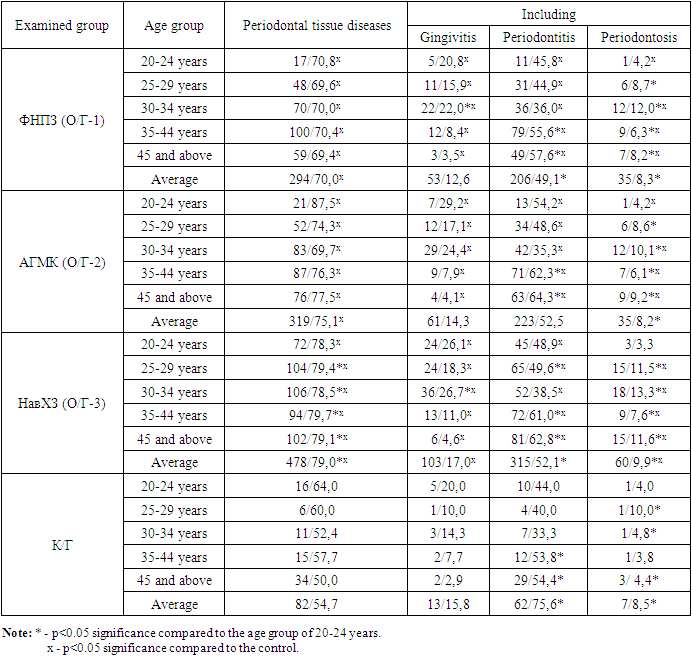 |
| |
|
Among the surveyed workers in the main groups (FNR, AMMC, NCP), the clinical picture of periodontal tissue diseases (PTD) indicated severe atrophic processes of the periodontium - pale gums, fairly firmly attached to the teeth but not to the tooth necks, which were exposed mainly on the buccal and lingual sides. In such cases, there were no larger pathological pockets, no purulent discharge, and in some cases, there were no even DC and DD deposits. The highest level of gingivitis was noted in NCP workers - 21.5%; FNR - 17.8%; and AMMC - 15.5%; periodontitis was observed in FNR workers - 70.0%; AMMC - 69.4%; NCP - 65.8%, and in the control group - 10.0%, while periodontosis was 12.4%; - 9.7%; - 12.6%; - 5.3% respectively. Among the workers in the main groups, the inflammatory form predominated - about 84.6%. It is worth noting that the localized form of gingivitis prevailed (58.45%), and the process was most pronounced in the area of the frontal teeth. In contrast to the initial form, the developed form of PTD was more pronounced among NCP and FNR workers, with a faster progression and more pronounced in women (86.9%) than in men (71.6%). In our observations, it was noted that in severe cases of PTD, at the onset of the disease, teeth elongate, slightly loosen, shift from their place, the gap between them increases, especially the diastema between the two central incisors.When studying the frequency of diseases of the oral mucosa and lip (OML) among the surveyed individuals, the following indicators were determined: FNR workers - 37.8%, AMMC - 31.2%, NCP - 46.9%, and in the control group - 18% (Table №5). Among FNR workers, these pathologies were noted in 45.8% of cases in the age group of 20-24 years, 39.1% in the age group of 25-29 years, and 44.7% in the age group of 45 and older. Among AMMC workers, these pathologies were observed in 41.7% of cases in the age group of 20-24 years, and in the control group, in the age groups of 20-24 years (20%) and 25-29 years (30%). Among NCP workers, these pathologies were more commonly identified in the age group of 35-44 years (56.8%) and 45 and older (54.3%). It is also noteworthy that the most common lesion of the OML was leukoplakia: FNR - 17.4%; AMMC - 14.6%; NCP - 19.3%, while in the control group, it was 6.7%.Table 5. Periodontal diseases in the examined individuals depending on age (M+ in %)
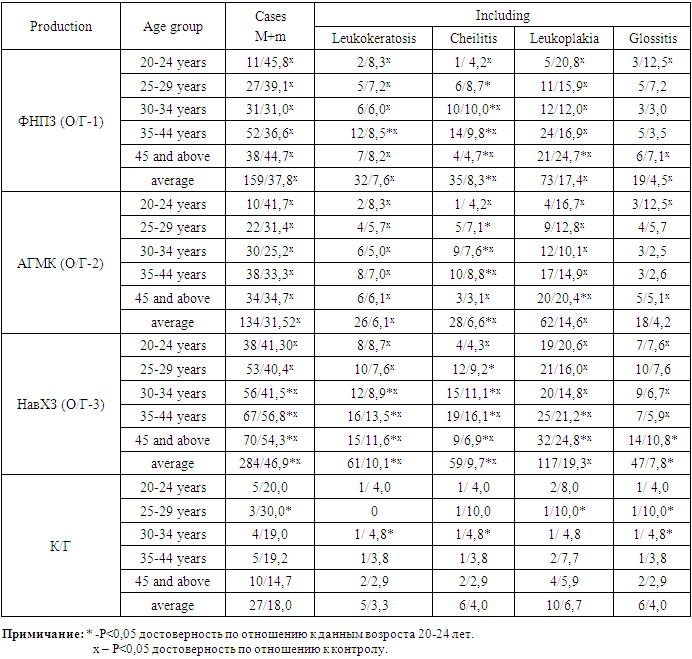 |
| |
|
It should be noted that the location of various elements of leukoplakia against the background of mucosal clouding is presumably caused by the influence of occupational hazards. It can also be assumed that mucosal clouding is the initial defensive reaction of the tissue to chronic irritation. The workers did not complain, and pathologies of the oral mucosa and lip (OML) were first detected during the examination of the oral cavity. Pathological formations on the oral mucosa were mostly symmetrically localized on both cheeks along the tooth occlusion line and in the area of the corners of the mouth. In most workers, these changes were located on the swollen, slightly hyperemic oral mucosa of the cheeks. Studying the diseases of the OML depending on gender, our research showed that in women, the incidence of OML was more common than in men. An analysis of the incidence by age showed that OML diseases are more common in older individuals, although they also occur in young age.Leukokeratosis was quite common, with mosaic formations located on the entire surface of the palate ranging in size from a pinhead to a lentil, white, wart-like plaques protruding on the skin surface, and having a drawn red dot in the center. These wart-like formations corresponded to hyperplastic minor salivary glands of the palate with a keratinized surface and a gland duct opening in the center. Also, tongue diseases were a fairly common form of OML lesions among workers at all examined plants. Initially, yellowish-white spots ranging in size from a lentil to a penny, round or oval, slightly protruding with a sharp border, were identified on the back of the tongue. The thickened epithelium of the papillae is detached from the surface of the spots, resulting in a characteristic clinical picture.At all plants, among the surveyed workers, individuals in need of prosthetics predominated; among FNR workers - 59.5%; AMMC - 59.05%; NCP - 56.2%, while in the control group - 7.35%; with dentures present - 8.8%; - 9.41%; - 10.1%; - 42.3% respectively. The proportion of workers not requiring prosthetics varied from 7.62 to 24.9%, and in the control group - 58.8%; workers with malocclusions - from 35.5% to 35.9% (Table №6). Among workers not requiring prosthetics, those with dentures present, and those in need of prosthetics, as well as those with malocclusions, there was no consistent pattern or correlation.Table 6. Orthopedic status of jaws in the examined individuals depending on age (M+ in %)
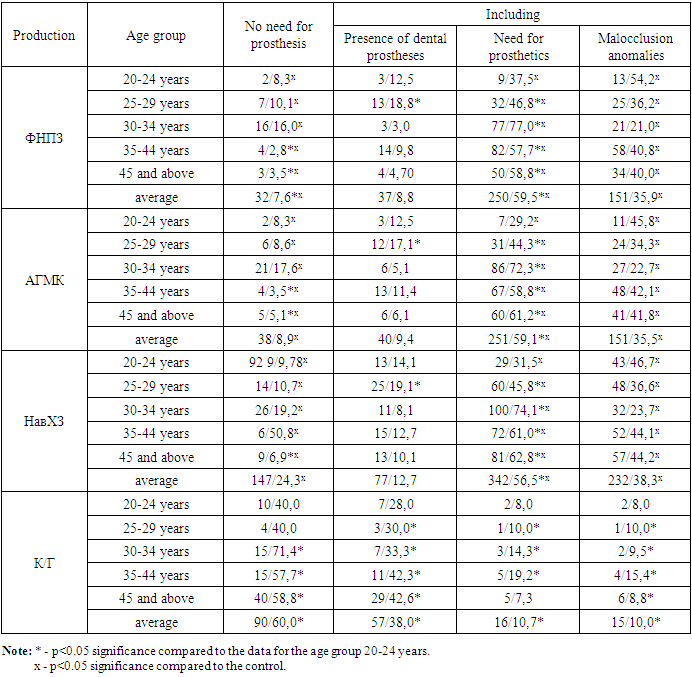 |
| |
|
With the aim of determining the functional state of the tooth pulp, electroodontometry (EOD) was conducted on 126 participants; among them, 35 were workers from each of the studied production groups (OG), and 31 were individuals from the control group (CG). The objects of the study were the central incisors (CI), canines (C), and first molars (M) of the upper jaw (UJ). In the absence or presence of fillings or crowns on them, teeth on the opposite side were examined. The electropulpability of 378 teeth was determined: on the CI of the UJ - 158, on the C of the UJ - 145, on the M of the UJ - 75. The analysis of the data for OG-1 revealed a decrease in excitability threshold - the maximum value on the CI was 52 μA, the minimum was 3 μA, with an average of 28+2.4 μA; on the C - 75 μA, the upper threshold was 2 μA, with an average of 33.4+1.8 μA; on the M, it decreased to 44 μA, the minimum being 6 μA, with an average of 40.3+2.4 μA. For workers in OG-2, the maximum value on the CI was 44 μA, the minimum was 8 μA, with an average of 23.3+1.2 μA; on the C - 62 μA, the upper threshold was 6 μA, with an average of 28.2+1.9 μA; on the M, it decreased to 43 μA, the minimum being 8 μA, with an average of 40.8+2.1 μA. For workers in OG-3, these indicators were: - 58 μA; - 4 μA; with an average of 29+1.4 μA; 85 μA; - 1 μA, with an average of 31.4+3.8 μA; 40 μA, 4 μA, with an average of 35.3+1.4 μA, respectively. Meanwhile, the results of the studies on individuals from the CG show that in individuals with intact teeth, the excitability threshold was within the range of 5 to 9 μA, with an average of 7.5+1.2 μA on the CI, 4.4+1.2 μA on the C, and 5.2+2.2 μA on the M. Moreover, the reaction of different functional groups of teeth was the same, with only a tendency towards a decrease in the excitability threshold observed for the M. The maximum value reached 16 μA in individual cases, with a minimum of 2 μA. The analysis of the results characterizes a sharp decrease in the excitability threshold of all examined teeth in workers from OG-1, 2, and 3 compared to the CG (P<0.001). The amplitude of the decrease varied for different functionally oriented groups of teeth, with a decrease in electropulpability observed for the M and C by 4-7 times, and for the CI - by more than 4 times.Results of the study on the state of sensitivity of the neuroreceptor apparatus (NRA) of the oral mucosa and periodontal tissue in 120 examined individuals (including 30 from each group) revealed a more pronounced NRA on the vestibular surface of the alveolar process of the oral cavity compared to its oral part (P<0.001). In the oral mucosa, workers from OG in the area of the 4th tooth had a tendency towards an increase in the compound nerve action potential (CNAP) threshold compared to the palatal surface of the 2nd and 6th teeth (P>0.5 - P<0.05). The CNAP threshold in the area of the 2nd tooth of the palatal side of the In workers, the threshold of the CNAP in the area of the 2nd tooth of the palatal side was lower compared to the vestibular surface of the oral cavity (P<0.05), and the difference in indicators between the 2nd, 4th, and 6th teeth was insignificant (P>0.05). When determining the threshold of the compound nerve action potential (CNAP) in individuals from the control group (CG), it was found that compared to the buccal mucosa, the most sensitive area is the vestibular surface of the gingiva (P<0.001). In workers from the study groups (OG), a statistically significant (P<0.01) decrease in CNAP was observed in all investigated areas. Comparing the sensitivity indicators of the tongue dorsum and buccal mucosa did not reveal significant differences (P>0.05), while a significant difference was observed between the indicators of the buccal mucosa and cheek (P<0.01). The research results confirmed a decrease in the thresholds of CNAP and compound nerve action potential (CNAP) in workers from the study groups (OG).To study taste sensitivity (TS) of the tongue, research was conducted on 75 individuals (20 workers from each OG and 15 individuals from the CG). It was found that approximately 45 individuals complained of disturbances in taste sensations. Various disorders of TS on the tongue were noted in workers from OG for all types of solutions used: an increase in taste sensation thresholds was observed most frequently for sour - 31.2% and bitter - 25%, while a decrease was most pronounced for sweet - 53.1% and salty - 59.4%: in workers from OG-2 - 45.2%; - 34.7%; 41.2% and 39.2%; OG-3 - 22.8%; - 28.9%; 66.8% and 62.5%, respectively. Moreover, when determining the threshold for sweet and salty tastes, distortion of TS towards sour and sour-bitter tastes was mostly noted: OG-1 - 42.8%; - 34.6%; OG-2 - 33.4%; - 33.2%; OG-3 - 55%; - 44.8%, respectively. When determining the threshold for sour and bitter tastes, distortion in the form of a sour-bitter sensation was noted in OG-1 - 22.4%; - 31.1%; OG-2 - 43.6%; - 48.2%; OG-3 - 35%; - 24.8% of cases, respectively. The obtained data indicate a decrease in taste sensitivity to sour and bitter tastes in workers from OG and show a significant difference compared to the CG.The results of the investigation of microhardness (MH) of tooth enamel (55 molar teeth; 20 teeth from OG-1; 20 teeth from OG-2; 15 teeth from OG-3) extracted due to severe periodontitis with mobility degree IV and extracted for various reasons, 10 teeth from individuals in the CG were examined. The enamel of the superficial layer was significantly harder than in other layers (P<0.001). The MH in the thickness of enamel was significantly higher than at the dentino-enamel junction (P<0.001) but lower than on its surface. The MH of tooth enamel in workers from OG was significantly increased in all studied layers compared to the CG (P<0.01). Also, in workers from OG, an increase in MH in the dentin and at the enamel-dentin junction was noted compared to the CG (P<0.01), and a decrease compared to workers from the chemical industry (P<0.001). In the thickness of dentin, in its central part and in the tooth cavity, there was a tendency towards an increase in MH compared to the CG (P>0.05); the results of the conducted research show that in workers from OG-2, there is an increase in MH in enamel and dentin, while in workers from OG-1 and 3, there is a sharp decrease in MH of all examined areas on the surface of enamel and in its thickness.When studying the data of the acid resistance test (ART) in workers from the food industry, chemical industry, and agricultural machinery manufacturing, it was found that the intensity of staining of the enamel erosion site ranged from 10 to 100% on the blue color scale. Depending on the staining intensity, four levels of resistance to caries were conditionally distinguished (Table №7): level 1 from 10 to 30%, level 2 - 30-40%, level 3 - 40-50%, level 4 - over 50%.Table 7. Changes in functional indicators of the oral cavity among the examined individuals
 |
| |
|
In workers from OG-1, level 1 of tooth resistance to caries was observed in 23.2% of workers; level 2 - in 21.8%; the majority of workers (55%) had level 3-4 enamel resistance; in OG-2 - 33.2%; - 32.3% and 34.5%; in OG-3 - 21.2%; 27.7% and 52.9%, respectively; and in CG - 44.2%; - 32.8% and - 22.4% of resistance, respectively.The results of the investigation of the pH of mixed saliva in workers from the studied industries show that saliva has a slight shift towards acidity at -1, -2, and -3 OG, while in individuals from the CG, the pH of mixed saliva was 6.8.Conclusions. Thus, the levels and the proportion of major dental diseases in workers from the studied industries remain quite high; on average, the prevalence of caries is 90.43; caries increment - 0.89; chemical necrosis of teeth - 18.43%; pathological tooth wear - 33.2%; mechanical enamel damage - 19.9%; deformation and defects of teeth and dental arches - 18.5%; periodontal tissue diseases - 74.7%; CNAP diseases - 38.7%; need for prosthetics - 58.4%, and pathology and anomalies of dental arches and joints - 36.6%, compared to the data of individuals from the CG, the prevalence of all types of dental pathologies is determined to be more than 1.5 to 5.5 times higher.The state of functional indicators and non-specific reactivity of PR tissues in workers is disrupted, with a decrease in the excitability threshold of teeth and peri-tooth tissues (by 4-6 times), as well as the thresholds of CNAP, TS, and CNAP (by 25-59.4%), changes in the microhardness of tooth enamel and dentin, which are most noticeable in the superficial layer (by 13%), and then spread into the depth of the teeth (by 11.8% in enamel thickness, by 1.2% - in the dentino-enamel junction). Thus, the data obtained from the study of the parameters of electrometry of hard tooth tissues, ART, CPV, GI, PI, RMA, microhardness of tooth enamel, and pH of mixed saliva of PR convincingly indicate the need for in-depth scientific research to determine the etiological factors of pathological processes in PR organs and tissues, to improve the quality of dental services, and to expand the methodology of specialized medical dental care for workers in various industries.
References
| [1] | Andakulova Z., Saidov A.A., Nazarov U.K., Gafforov S.A. Some features of the dynamics of morbidity of workers of the production association "Ferganaazot" with temporary loss of work capacity. Journal of Theoretical and Clinical Medicine, No. 4, pp. 15-17. Tashkent-2008. |
| [2] | Bekmetov M.V., Agzamkhuzhaev S.S., Nazarov U.K., Olimov S.Sh., Gafforov S.A. Structural and functional state of the oral cavity in workers of furan compound production. Problems of Dentistry, No. 4, pp. 15-18. Kazakhstan-2008. |
| [3] | Danilov V.B. Hygiene and toxicology of furan polymers. Tashkent: Fan, 1985. 140p. |
| [4] | Zholudov S.E., Nazarov U.K., Gafforova S.A. Study of the level of functional and structural state of oral tissues in individuals employed in Almalyk and Nizhnetagil metallurgical productions. Ural Medical Journal, No. 12, pp. 5-8, 2019. Russia. |
| [5] | Ibragimova F.I., Gafforov S.A. Clinical-biochemical substantiation of the course and treatment of diseases of periodontal tissues and oral mucosa in workers of synthetic detergents and cleaning agents production. Medical Journal of Uzbekistan, No. 4, pp. 45-50, 2019. Tashkent. |
| [6] | Idiev G.E., Agzamkhuzhaev S.S., Gafforov S.A. Frequency and clinic of non-carious lesions of teeth in workers of the production association "Navoiyazot". Bulletin of the Association of Doctors of Uzbekistan, No. 4, pp. 110-112. Tashkent-2001. |
| [7] | Idiev G.E., Gafforov S.A. Diseases of the oral mucosa in workers of certain branches of the chemical industry of the Republic of Uzbekistan. Proceedings of the 4th International Medical Congress of Students and Young Scientists. Ternopil, pp. 332. May 21-23. Ukraine-2002. |
| [8] | Nazarov U.K., Gafforova S.A., Belenova I.A., Gafforov S.A. Substantiation of morphostructural changes in the organs of the oral cavity in individuals employed in mining and metallurgical productions. Collection of papers from the 12th International Scientific and Practical Conference "Dentistry of Slavic States". Belgorod, pp. 101-103. 2019. |
| [9] | Olimov S.Sh., Gafforov S.A. On the issue of air pollution in workshops of the production association "Ferganaazot". Bulletin of the Association of Doctors of Uzbekistan, No. 1, pp. 74-76. Tashkent-2009. |
| [10] | Olimov S.Sh., Idiev O.E., Gafforov S.A. Diseases of hard tooth tissues in the production of natural gas processing. Bulletin of the Association of Doctors of Uzbekistan, No. 3, pp. 71-74. Tashkent-2007. |
| [11] | Saidov A.A., Akhmadaliev N.N., Gafforov S.A. Changes in some biochemical indicators of saliva in workers of the textile industry. Bulletin of the Ural Medical Academic Science, No. 4 (32), pp. 21-23. Russia-2010. |
| [12] | Talakin Yu.I., Ivanitskaya N.F., Maltseva G.A., et al. Gas chromatographic determination of a new heat carrier monobenzoltoluene in the air. Hygiene and sanitation, 1988, No. 10, pp. 62-63. |
| [13] | Shamsutdinova F.T., Gafforov S.A. On the issue of hygienic assessment of working conditions for workers in cement production. Journal of Theoretical and Clinical Medicine, No. 1, pp. 88-91. Tashkent-2006. |
| [14] | www.who.int/ru |



 Abstract
Abstract Reference
Reference Full-Text PDF
Full-Text PDF Full-text HTML
Full-text HTML





